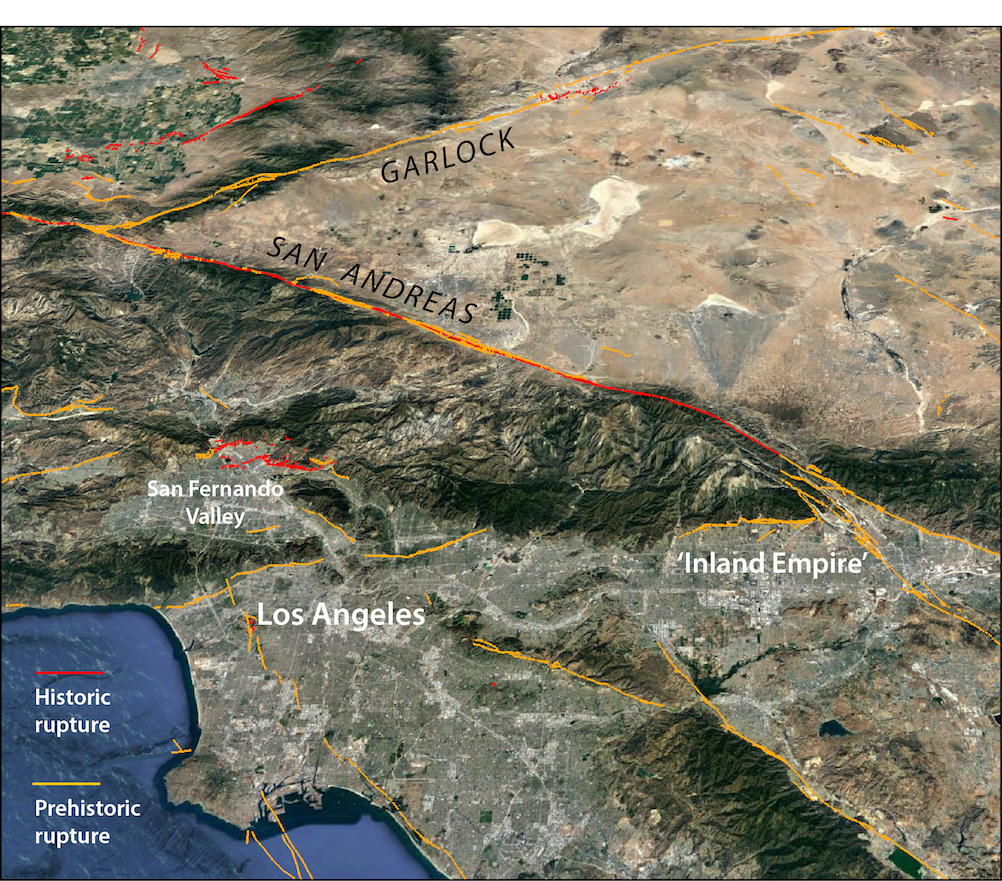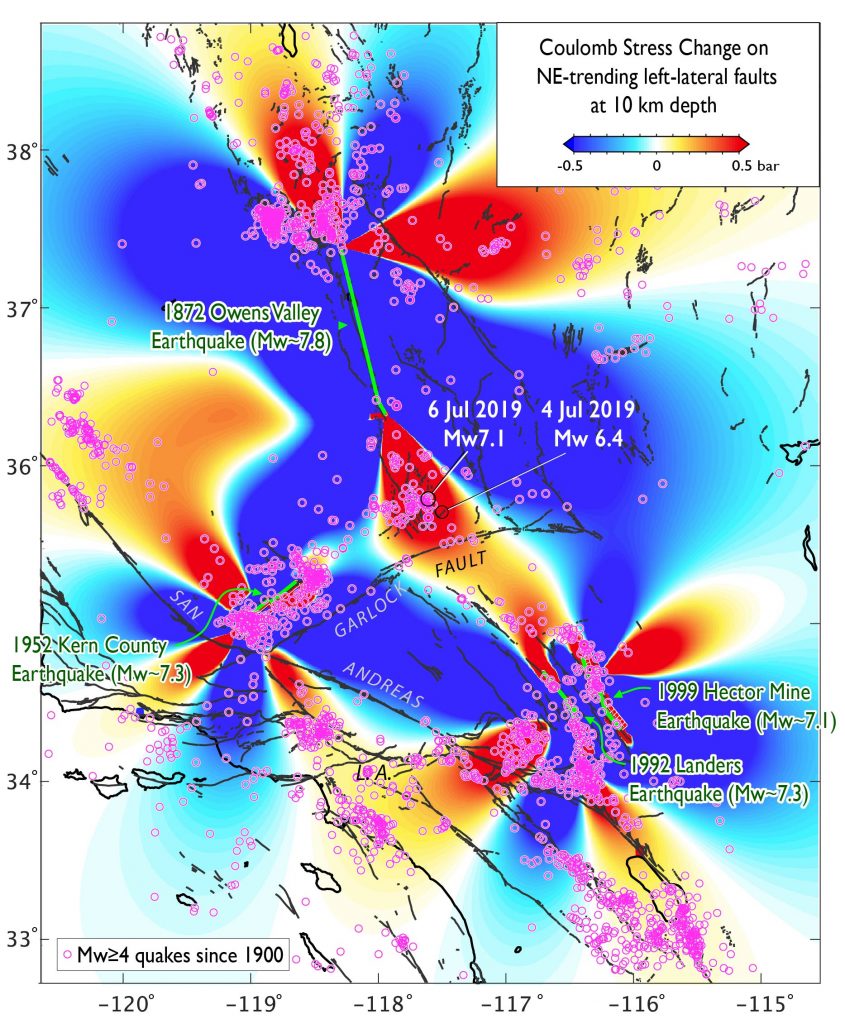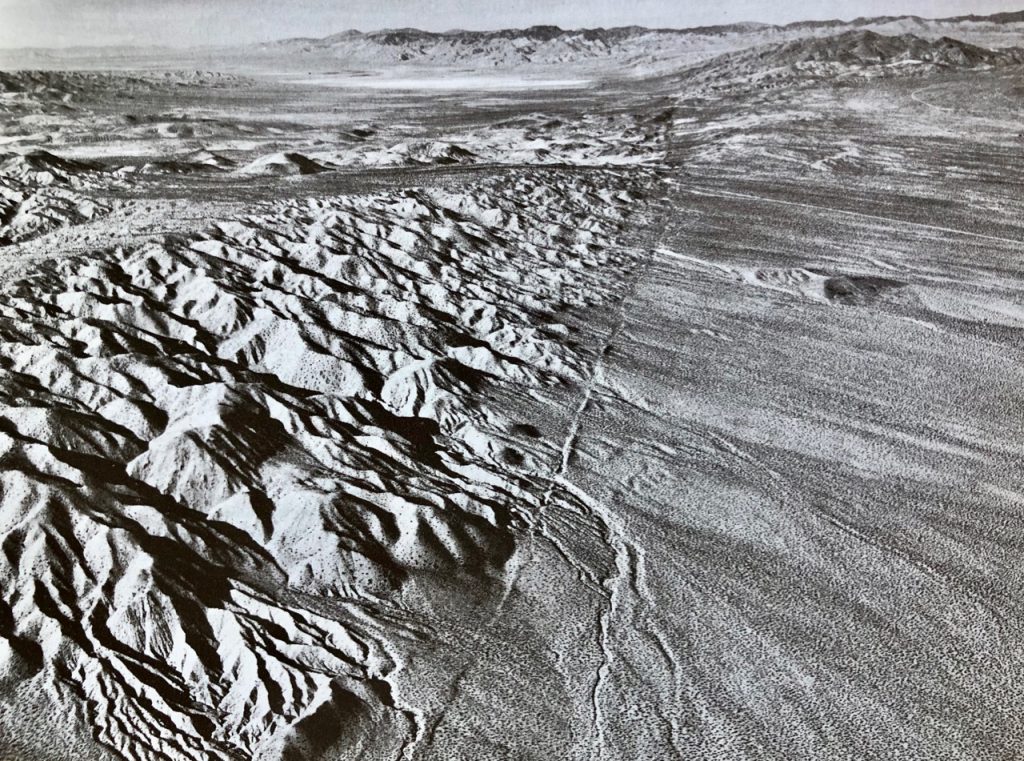The 2019 Ridgecrest quakes stressed the Garlock Fault. If it ruptured in a large shock, it would likely trigger a San Andreas earthquake north of Los Angeles.
By Ross S. Stein, Ph.D., Temblor, Inc. CEO, and Shinji Toda, Ph.D., IRIDeS, Tohoku University
Citation: Stein, R. S., Toda, S., 2020, Ridgecrest earthquakes could cause a San Andreas chain reaction, Temblor, http://doi.org/10.32858/temblor.103

The 2019 magnitude-6.4 and magnitude-7.1 Ridgecrest earthquakes were largely unforeseen. They struck on faults that had not been mapped, and, in a rare order of events, the larger quake followed 34 hours after the smaller one. Fortunately, these large shocks occurred in the remote southern California desert, so caused no deaths and only modest damage.
But the Ridgecrest ruptures could have far-reaching effects because the Garlock Fault links the Ridgecrest faults with the San Andreas Fault. So, what, if anything, can now be foreseen? That is the question we probed in a study published today in the Bulletin of the Seismological Society of America (Toda and Stein, 2020).
Setting the stage for Ridgecrest
In the 150 years prior to the 2019 Ridgecrest quakes, four magnitude-7.0+ shocks struck up to 90 miles (150 kilometers) away. We find that these quakes added stress to the newly discovered Paxton Ranch and the Salt Wells Valley Faults that would eventually rupture in 2019. The increase in stress was only about 3% of what was released during the 2019 earthquakes. This means that the magnitude-7.0+ events did not directly cause the Ridgecrest earthquakes, but they may have promoted it.
The map below highlights areas that are stressed (red-yellow) as a result of these magnitude-7.0+ events. When we plot magnitude-4.0+ quakes since 1900 on this map, we find that most lie in the red-yellow regions, areas that are stressed as a result of these four larger quakes. Thus, it seems clear that these four large events influenced not just the Ridgecrest rupture, but also the broad pattern of southern California seismicity.

In pursuit of accurate earthquake forecasts
In our study, we developed a new method to forecast future seismicity. These forecasts are not earthquake predictions, which have so far proven impossible. Rather, they are probabilistic, framed in the language of chance. We use past seismicity, the stress imparted by recent large and moderate earthquakes and the equations governing how fault friction varies in time and space (‘rate-state friction’) to estimate the likelihood of future earthquakes of different sizes.
In an application of machine learning, we use a ‘learning period’ to tune the model. These so-called ‘retrospective forecasts’ of quakes that have already occurred enable us to improve and assess the forecast’s fidelity to actual earthquake occurrence.
A key element of our method is that we do not use idealized continuous planar faults as the ‘receivers’ of earthquake stress; rather, we use focal mechanisms within six miles (10 kilometers) of those faults instead. Because faults are fractal in character (they look roughly the same regardless of scale, with branches, bends, and breaks), we find stress on focal mechanisms provides more realistic assessments of stress transfer than stress on simple planar surfaces.
Below is our earthquake forecast for southern California for the next year. The red areas — those with the highest earthquake potential — are generally close to the Ridgecrest rupture, but some are up to 60 miles (100 kilometers) away. In a blind test of this forecast, we see that the two largest shocks to have struck since 9 July 2019, a magnitude-5.8 earthquake on June 24, and a magnitude-5.5 shock on June 4, are consistent with the forecast.

Is the Garlock now in play?
When we sum up the earthquake probability along the entire length of the Garlock Fault, the main fault that runs perpendicular to the Ridgecrest faults, we estimate a 2.3% chance of a magnitude-7.7 Garlock Fault rupture in the next year — in other words, one chance in 43. This is 100 times higher than its annual chances in the ‘UCERF3’ benchmark model for California, which is jointly issued by the USGS, the Southern California Earthquake Center, and the California Geological Survey (Field et al., 2014; Field et al., 2015).
After the 2019 events, a very shallow portion of the Garlock slipped slowly, a process known as ‘creep’, perhaps in response to the stress imparted by the Ridgecrest earthquakes, or perhaps due to the ground shaking. But thus far, the Garlock Fault hasn’t otherwise budged. That does not mean it won’t: large progressive ruptures separated by months to years are not uncommon; since 1939, the North Anatolian Fault in Turkey has had many.

Could the Garlock Fault produce a very large rupture? The fault appears to have ruptured in large earthquakes during the past 600 years, and so could presumably do so again. McGill and Sieh (1993) and Dawson et al. (2003) found evidence for large events during A.D. 1450-1640, and A.D. 1490-1810 along the central Garlock Fault. Madden et al. (2012) found evidence for six earthquakes in the past 5600 years along the western Garlock Fault, 30 miles (50 kilometers) from its junction with the San Andreas.
A Garlock rupture could cause a San Andreas quake
If a Garlock Fault ruptured to within about 30 miles (45 kilometers) of its junction with the San Andreas Fault, we calculate it would raise the probability of a San Andreas rupture extending to the southeast, on the so-called ‘Mojave section,’ by factor of about 150. That translates into a 50/50 chance of a San Andreas Mojave section rupture (with a range, 25%-67%), either immediately following a Garlock quake, or after some delay. We thus estimate the net chance of a large San Andreas earthquake in the next 12 months to be 1.15%, or 1 chance in 87.
While small, this probability is 3.5-5.0 times higher than the annual chance of a large San Andreas earthquake in the ‘UCERF3’ benchmark model for California (Field et al., 2014; Field et al., 2015).

Perspective
A 1.15% chance of a great San Andreas rupture in the next year is low; it is the same as saying that there is a 98.9% chance it won’t rupture. So, no one should panic. But, as we have seen during the COVID-19 pandemic, low probability chain-reaction events do occur in nature, and when they do, their consequences can be great. It is the responsibility of scientists to assess the likelihood of such events, and then to bring them to the attention of the public and decision-makers.
Virtually all California insurance premiums are tied to UCERF3 earthquake rates. In the wake of the Ridgecrest earthquakes, our results indicate that those benchmark probabilities are too low, which matters for what we pay as homeowners, and for what risk the insurers are taking.
Silver lining
Because of the location of the Garlock Fault with respect to the San Andreas Fault and Los Angeles basin, there is a silver lining. A large Garlock rupture that propagates towards the San Andreas and triggers a large San Andreas earthquake might be the ideal scenario to deliver a relatively long Earthquake Early Warning to the residents of greater Los Angeles. An early earthquake alert received perhaps tens of seconds rather than seconds before shaking would give people precious time to ‘drop, cover and hold on’.
Concerned about your earthquake risk? Check it at Temblor.
We gratefully acknowledge funding from and collaboration with the Willis Research Network, and an SBIR Phase II award from the U.S. National Science Foundation.
For more coverage of this paper, read here:
Further reading
Dawson, T. E., S. F. McGill, and T. K. Rockwell (2003). Irregular recurrence of paleoearthquakes along the central Garlock fault near El Paso Peaks, California, J. Geophys. Res. 108, no. B7, 2356, doi:10.1029/ 2001JB001744.
Field, E. H., R. J. Arrowsmith, G. P. Biasi, P. Bird, T. E. Dawson, K. R. Felzer, D. D. Jackson, K. M. Johnson, T. H. Jordan, C. M. Andrew, A. J. Michael, K. R. Milner, M. T. Page, T. Parsons, P. M. Powers, B. E. Shaw, W. R. Thatcher, R. J. Weldon II, and Y. Zeng (2014). Uniform California Earthquake Rupture Forecast, Version 3 (UCERF3), The Time-Independent Model, Bull. Seismol. Soc. Amer. 104, no. 3, 1122-1180, doi: 10.1785/0120130164
Field, E. H., G. P. Biasi, P. Bird, T. E. Dawson, K. R. Felzer, D. D. Jackson, K. M. Johnson, T. H. Jordan, C. Madden, A. J. Michael, K. R. Milner, M. T. Page, T. Parsons, P. M. Powers, B. E. Shaw, W. R. Thatcher, R. J. Weldon, Y. Zeng (2015). Long‐term time‐dependent probabilities for the Third Uniform California Earthquake Rupture Forecast (UCERF3), Bull. Seismol. Soc. Am. 105, no. 2A, 511–543, doi: 10.1785/0120140093.
Madden Madugo, C., J. F. Dolan, and R. D. Hartleb (2012). New paleoearthquake ages from the Western Garlock Fault: Implications for regional earthquake occurrence in Southern California, Bull. Seismol. Soc. Amer. 102 (no. 6), 2282–2299, doi: 10.1785/0120110310.
McGill, S., and K. Sieh (1993). Holocene slip rate of the central Garlock fault in the southeastern Searles Valley, California, J. Geophys. Res. 98, no. B8, 14,217 – 14,231, doi: 10.1029/93JB00442.
Toda, S., and R. S. Stein (2020). Long- and Short-Term Stress Interaction of the 2019 Ridgecrest Sequence and Coulomb-Based Earthquake Forecasts, Bull. Seismol. Soc. Am. XX, 1–17, doi: 10.1785/0120200169.
- Magnitude 7 Yukon-Alaska earthquake strikes on the recently discovered Connector Fault - December 8, 2025
- Upgrading Tsunami Warning Systems for Faster and More Accurate Alerts - September 26, 2025
- April 2025 magnitude 6.2 earthquake near Istanbul highlights strengths and weaknesses in seismic mitigation - September 14, 2025
